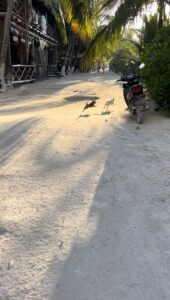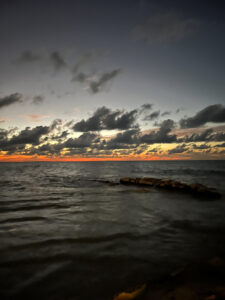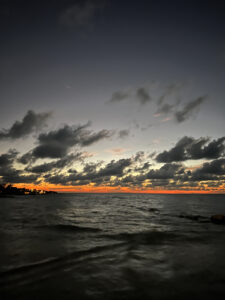
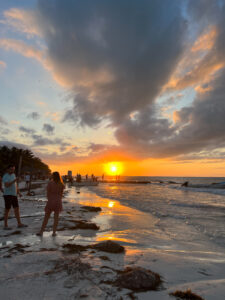
I first became aware of Isla Holbox because I follow their quasi-famous animal rescue on Instagram, and that seemed like enough indication that I would love the island. Refugio Animal Holbox is a no-kill rescue that saves dogs, other pets, and wildlife from all over the island, and they do an incredible job of marketing their volunteer shifts as tourist opportunities. Several of the hostels and hotels in town offer dog walking at the shelter as a unique island activity. After doing a similar tourist-advertised volunteer walk at a rescue in Croatia, I wonder why animal shelters in all tourist hubs aren’t doing the same thing. I am not exaggerating when I tell you that Refugio Animal Holbox was the biggest reason that I wanted to go to Holbox.
Aside from the shelter, Holbox didn’t seem like an obvious place for me to go. As I’ve written before, I’m terrible at beach vacations. I’m so pale I’m practically translucent, and sitting in direct sunlight for more than 10 minutes ensures days of misery to follow. Plus, I’m too restless for beach sitting. I’m not a great swimmer. The combination of sand and sweat is entirely unappealing. A Mayan Riviera vacation would simply be wasted on me.
And yet… It felt wrong to spend three weeks on the Yucatan Peninsula and NOT see one of its famous beaches. And of all the beach destinations available, Holbox seemed like the right one. There were a lot of things that drew me to the island. Most of what I’d read online said Holbox was like Tulum 15 years ago—a still undiscovered gem that you should get to before the masses arrived. There are no cars allowed on the island. You can only get there via ferry, and everyone travels by foot, bike, or golf cart. It’s safe and affordable (or so said Google), devoid of resorts, high-rise condos, and chain restaurants. And there were plenty of activities for a person not interested in beach-sitting. I could take a midnight bioluminescence tour. I could go kayaking. I could go horse-back riding. I could swim with whale sharks! And I could walk sweet dogs every morning and evening. Nearly everyone I know who had been said it was gorgeous. So I booked two nights at a hostel near the ferry dock.
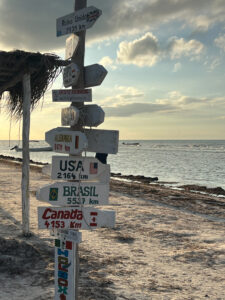
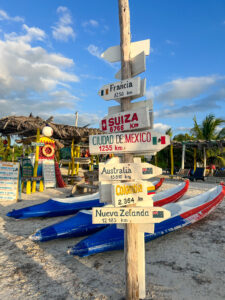
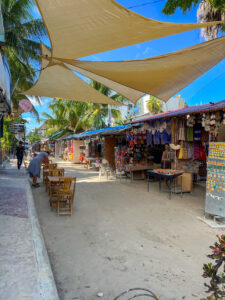
I will confess that a lot of my negative experiences in Holbox were circumstantial. Some of them were my fault entirely. Things started to go wrong before I even left Merida. It was a weekday in the off-season, and it hadn’t occurred to me that the direct bus from Merida to Chiquilá (the town where the Holbox ferry departs from) would sell out days in advance. A wave of dread washed over me when I logged onto the bus website a couple days before I intended to leave and saw that the bus tickets were sold out. I didn’t panic though—I scolded myself for the mistake and bought a ticket to Cancun and then a ticket from Cancun to Chiquilá instead. It cost me a few hours and I had to pay twice the price for two tickets, but it wasn’t a huge deal.
When our bus arrived in Chiquilá, I followed the crowd to the ferry ticket booth where the attendant told me that he didn’t accept credit cards. I had some cash with me, but not enough for a ticket. I’d planned to get cash immediately after arriving. The dread rushed back. There’s no way, I thought. There’s no way that every person in this line knew they had to have cash. I asked the attendant where the nearest ATM was, and he rolled his eyes as if I were the most obnoxious person he’d ever encountered in his life. “On the island,” he told me. “There isn’t one here.”
He waved me aside, and for ten minutes I dug through every one of my bags searching for more cash and furious with myself for not getting cash before I left Merida. I tried to brainstorm plans so I didn’t panic. Maybe I could find an American who had extra cash and Venmo them. Maybe I could offer the ticket guy more money in US dollars. When I got back in line after everyone else had left with their ferry tickets, the attendant looked at me with disgust and pulled a credit card machine from under his counter. “You can use a card, but it’s 5% extra.” I stared at him, dumbfounded. “That’s no problem,” I told him, as if I were entirely unbothered. I’d just spent two weeks in Merida where everyone was overly welcoming and hospitable. The contrast felt deeply depressing. And this was the first indication that many interactions in Holbox would feel like transactional cash grabs.
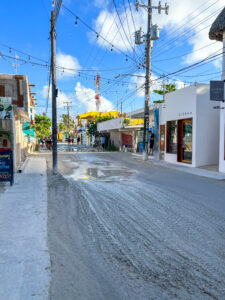
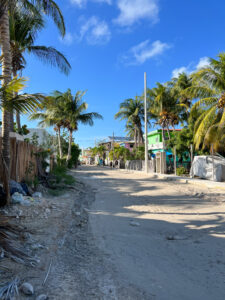

The half-hour ferry ride to Holbox was lovely, but as soon as we departed the boat, I saw the mud. Despite all the research I’d done, I hadn’t realized that Holbox becomes nearly impossible to navigate by foot after even the mildest rainstorm. I’m not exaggerating when I tell you that the mud puddles were the length and width of swimming pools. There were places where you simply could not get down a street without trudging through mud to your shins. All the roads were dirt, so there was no way to escape it. The standing water invited seemingly every mosquito on the continent. I tried to remind myself that it was silly, privileged, and dramatic to be bothered over some mud puddles. At the same time, I also live in a place that deals with extreme flooding, and in New Orleans, it’s not dramatic to recognize that there is a level of flooding that makes the city inoperable. This was not the case in Holbox.
My hostel was just a few blocks from the ferry, but it took me half an hour to find a walkable route around the mud to get to it. The route involved walking over a rickety little plank that someone propped on some trash. On my walk, I started noticing the trash everywhere. Because Holbox is an island, it’s more complicated to remove trash than it would be on the mainland. And as tourism has increased, the overdevelopment hasn’t been sustainable. The trash had piled up in yards, on properties, around construction, and in random fields.
Do not believe the blogs that tell you this is an undiscovered gem—Isla Holbox has long-been discovered and is catering to a wealthy tourist crowd willing to pay $20 for their morning smoothie bowls while the tiny family home next door looks like it may not have electricity. The shocking inequality and gentrification that I hadn’t visited Tulum to avoid was here too.
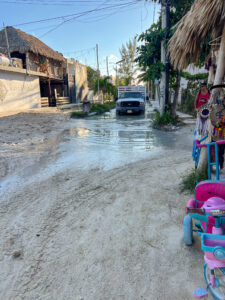
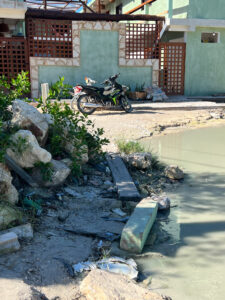
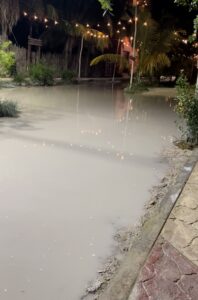
It was entirely my fault that I accidentally stayed in a party hostel. I picked a hostel that was part of a local chain I’d also stayed in for a few nights in Merida (Che Hostels) because the pictures looked pretty and it had good reviews. There was no one to blame but me. I had two roommates in my 4-bed dorm—two Australian guys in their mid-20s. They were polite the few times I saw them awake, but they’d leave to go party when I was getting back to the room to go to bed. They’d come back at 2:00am and try to be quiet, but there was no possibility it wasn’t going to wake me up. Their efforts at being quiet didn’t matter anyway. The karaoke and pool parties at the hostel lasted nearly as long, and the door blocked approximately zero percent of the sound.
I joined the Whatsapp group for the hostel when I checked in, and I kept getting increasingly wild group texts from the staff at the hostel. “Hey crazy peopleee Tomorrow we have a big island party we gona make a huge party all the afternoon starting on the boat… gona make some drinking games, music, party, dancing… TEQUILA BOOM BOOM. Are you readyys for that???” Yes, that is a direct quote. And no, I was not ready for that. I’d recommend the hostel to anyone under the age of, say, 22. And only if they are interested in copious amounts of alcohol and loud music. Otherwise, this is the wrong choice.
On my first evening in Holbox, I tried to get dinner and quickly found that the vast majority of restaurants on the island didn’t accept credit cards. Luckily I was able to get cash from one of the 2 or 3 ATMs on the island, even though locals told me that the machine was often out of cash. I was determined to walk a dog from the shelter that evening so that my trip to the island hadn’t been a waste. And I did. Balloo the dog and I trudged through mud up to my ankles to get to the beach. The seasonal algae was waiting for us there, but I didn’t care. My all-natural mosquito repellent did almost nothing, but the sunset was beautiful. Refugio Animal Holbox deserves all the special awards for figuring out how to operate in these conditions and continuously bringing animals to safety. They were my favorite part of the island.
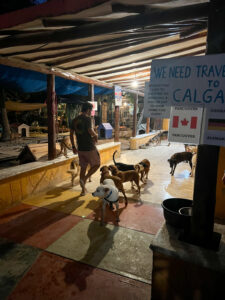
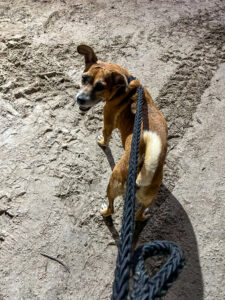

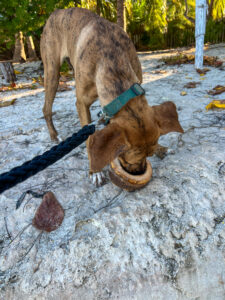
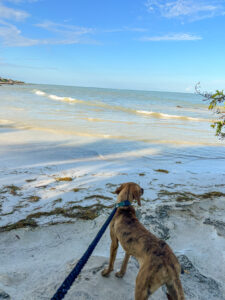
I was determined to have a better day the next day. I started my morning with a smoothie and a slice of banana bread for just $16 (which is to say, more money than I’d pay for the same thing back home in New Orleans). Then I headed toward Punta Coco beach, supposedly the most beautiful beach on the island. I’d checked out the price for some beach activities like horse-back riding and the bioluminescence tours, but they were far out of my budget, so I decided that a relaxing day of island exploration would be the right way to spend my only full day there.
I headed toward Punta Coco on the beach. It was a lovely 30-minute walk before I got to a point where the trees reached into the water and the beach stopped. I turned inland and walked a few blocks before I arrived at my first swimming-pool sized puddle. A girl who’d been following behind me for a while joined me as I surveyed it. We agreed that there was simply no choice but to walk through it. I left my Teva sandals on as we trudged through the mud because I was afraid of broken glass or sharp objects at the bottom. We could see the beach just three blocks ahead of us as the mud reached our knees. I’d walked 40 minutes at that point, and I refused to turn back. But by the time I reached the beach, the sand and mud under my Teva straps had rubbed giant blisters in multiple spots on each foot. The other girl refused to be deterred and went to bake on the beach for a while. I looked at the beach for about two minutes before deciding that was sufficient and I was ready to go back to my room. I took a look at the beach, which was fine but not prettier than any other beach on the island, and then I asked a man at the snack stand how I could summon a taxi back to town. Wait here, he told me, pointing toward a bench. I sat on the bench imaging the flesh-eating bacteria that was undoubtedly creeping through my blisters.
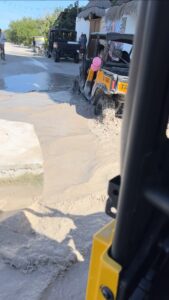
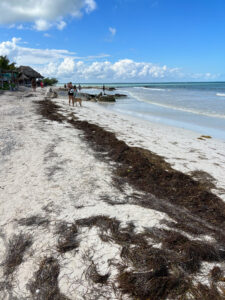
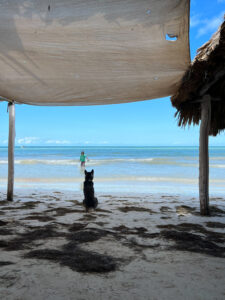
A middle-aged Mexican man named Antonio joined me on the bench, and the snack man asked us if we would be okay sharing a taxi. When we agreed, he pointed 3 blocks away at one of the 4-wheel jeep/ATV things used as taxis on the island. “There’s your taxi,” he said. “Won’t it come here?” I asked. He shook his head and pointed. So Antonio and I trudged together through mud quite literally to my thighs to get to the taxi. One puddle was so deep that we held hands so we could both keep our balance as we stumbled over rocks and crevices we couldn’t see. It felt like a scene in Jurassic Park. And though I could objectively recognize the humor in this situation at the time, I was also certain the flesh-eating bacteria was going to kill me immediately. Once we finally made it to our taxi, we realized that it was sitting at the end of a boardwalk to the beach. If the snack man had just told us, we could have walked ten minutes on the beach and never had to step in a puddle.
Our taxi ride back to town felt like riding the safari ride in Disney’s Animal Kingdom, and at times the mud we drove through was so deep it washed over my wounded feet. Back in the hostel, I slathered Neosporin all over my feet, and I limped around in my shower shoes (Croc flip-flops) for the rest of my time in Holbox.
That night I walked another dog named Salma, ate overpriced and overcooked coconut shrimp, and shopped in a few local shops before watching the sunset with the crowd by the pier. The next morning, I had a delicious (and surprisingly affordable) smoothie bowl alone at one of the most popular restaurants in town because no one else was awake before 10:00am. Then I packed my bags while my roommates were still asleep, eager to get to the ferry as fast as I could. Of course, the ferry I planned to take was NOT the one my roundtrip ticket covered, so I spent about an hour certain I was going to miss my next bus. But I didn’t. I made it on the bus with just a few minutes to spare, very glad to be leaving Holbox behind.

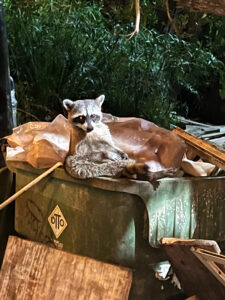

How does one write about a place where they had a bad time while acknowledging that many others would love it? So many people adore Holbox, and as I said, much of what I didn’t love was circumstantial. But it is worth noting the realities of the island like how it is no longer an “undiscovered” paradise and how you should expect high prices. A “car free” island doesn’t mean that it’s lacking in motor vehicles (there are delivery vehicles as well as ATVs and golf carts). You’ll read that Holbox is a place that focuses on eco-tourism and sustainability, but the overdevelopment and trash suggest that this is wishful thinking.
But I would consider going back and doing it differently. I’d love to do a bioluminescence tour. I’d bring a lot of cash. During the right season of the year, I’d love to swim with the whales. I would know to avoid the hostels and stay in private accommodations instead. I’d know to carefully keep track of the weather, both before my visit and during. I’d go back to walk more dogs at Refugio Animal Holbox. And if I had double the budget, I’d enjoy a lot of smoothie bowls. I’ve pet every stray dog I could find. (You can’t imagine how many precious stray dogs are waiting for you in Holbox.)
The blisters on my feet left scars for a couple months, but as you might have suspected, the flesh-eating bacteria didn’t find me after all.
